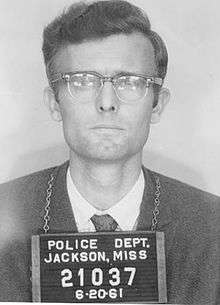Robert Martinson
| Robert Martinson | |
|---|---|
 Freedom Rider mugshot from 1961 | |
| Born |
May 19, 1927 Minneapolis, Minnesota |
| Died |
August 11, 1979 (aged 52) Manhattan, New York City |
| Cause of death | Suicide |
| Education | University of California, Berkeley. B.A., M.A., Ph.D. |
| Occupation | Criminologist |
| Known for | "Nothing works" doctrine regarding prisoner rehabilitation |
Robert Magnus Martinson (May 19, 1927 – August 11, 1979) was an American sociologist, whose 1974 study "What Works?", concerning the shortcomings of existing prisoner rehabilitation programs, was highly influential, creating what became known as the "nothing works" doctrine.[1] His later studies were more optimistic, but less influential at the time.[2] He served as chairman of the Sociology Department at the City College of New York, and then founded the Center for Knowledge in Criminal Justice Planning.[3][4]
Life and career
Martinson was born on May 19, 1927 in Minneapolis, Minnesota to Magnus Constantine Martinson and Gwendolyn A. Gagnon.[5][6][7] He received his degrees – BA (1949), MA (1953), PhD (1968) – from the University of California, Berkeley.[8][9]
In 1959 he ran for mayor of Berkeley, California as the Socialist Party candidate.[10]
Martinson was a participant in the 1961 Freedom Riders, spending over a month in two Mississippi jails, and wrote about his experience for The Nation.[4][8] He also wrote a longer academic study of the group dynamics within his cohort of imprisoned Freedom Riders.[11] His incarceration generated his interest in penology.[12]
He married Rita J. Carter on September 18, 1961 in San Francisco, California.[13]
Martinson's investigation with Douglas Lipton and Judith Wilks regarding rehabilitation of inmates in prison had been commissioned in 1966 by the New York State Governor's Commission on Criminal Offenders. It covered 231 earlier studies, dated from 1945 to 1967. Their first draft had been completed in 1970, but because the results were considered unsuitable, the report was initially suppressed. It later became available after an unrelated court case.[14]
Something of a public figure at the time, Martinson was interviewed by People magazine and on 60 Minutes (August 24, 1975), asserting that "nothing works" in prison rehabilitation. His work was embraced by politicians, and inspired a wave of strong sentencing and cancellation of rehabilitation programs.[15] Academics, however, strongly criticized his studies, for drawing conclusions from mostly untrained practitioners in underfunded programs, and he himself later reversed his stance.[16][17][18]
Martinson committed suicide on August 11, 1979 by leaping from his ninth floor Manhattan apartment.[17][19]
Works
- Martinson, Robert Magnus (1968). Treatment Ideology and Correctional Bureaucracy: A Study of Organizational Change (Thesis). University of California, Berkeley.
- Martinson, Robert (Spring 1974). "What works?—questions and answers about prison reform". The Public Interest: 22–54.
- Lipton, Douglas; Martinson, Robert; Wilks, Judith (1975). The Effectiveness of Correctional Treatment: A Survey of Treatment Evaluation Studies. New York: Praeger.
- Martinson, Robert (Winter 1979). "New Findings, New Views: A Note of Caution Regarding Sentencing Reform". Hofstra Law Review. 7 (2).
References
- ↑ Sarre, Rick (2005). "Beyond what works: A retrospective of Robert Martinson's famous article". In O'Toole, Sean; Eyland, Simon. Corrections Criminology. Hawkins Press. pp. 162–68. ISBN 187606-717-9.
- ↑ Sifakis, Carl (2003). "Martinson, Robert". The Encyclopedia of American Prisons. Facts on File. pp. 157–58. ISBN 0-8160-4511-9.
- ↑ "Records of the Center for Knowledge in Criminal Justice Planning". Lloyd Sealy Library, John Jay College of Criminal Justice. Retrieved 2015-08-09.
- 1 2 Wohlfert, Lee (Feb 23, 1976). "Criminologist Bob Martinson Offers a Crime-Stopper: Put a Cop on Each Ex-Con". People. 5 (7): 20.
- ↑ New York State death certificate issued August 11, 1979 in Manhattan, New York City via Michael S. Martinson
- ↑ Magnus C. Martinson and Robert Martinson in the 1930 United States census living in Minneapolis, Minnesota.
- ↑ "United States Social Security Death Index". Retrieved 2015-09-08.
- 1 2 Martinson, Robert (Jan 6, 1962). "Prison Notes of a Freedom Rider". The Nation: 4–6.
- ↑ Martinson 1979, p. 243.
- ↑ "6 Eastbay Freedom Riders Out of Jail". Oakland Tribune. July 29, 1961.
- ↑ Martinson, Robert (May 1967). "Solidarity Under Close Confinement: A Study of the Freedom Riders in Parchman Penitentiary". Psychiatry. 30 (2): 132–48.
- ↑ Martinson, Robert (Apr 8, 1972). "The Paradox of Prison Reform II: Can Corrections Correct?". The New Republic. 166 (15): 13.
- ↑ California Marriage Index, 1960-1985
- ↑ Empey, LaMar T. (Sep 1976). "Review". Contemporary Sociology. 5 (5): 582–83. JSTOR 2063298.
- ↑ Barkow, Rachel E. "The Court of Life and Death: The two tracks of constitutional sentencing law and the case for uniformity". Michigan Law Review. 107 (7): 1173.
- ↑ Abramsky, Sasha (2007). American Furies. Boston: Beacon Press. pp. 43–51.
- 1 2 Miller, Jerome (Apr 23, 1989). "Is Rehabilitation a Waste of Time?". The Washington Post. p. C3.
- ↑ Martinson 1979.
- ↑ "It Has Come to Our Attention". Federal Probation. 43 (4): 87. Dec 1979.